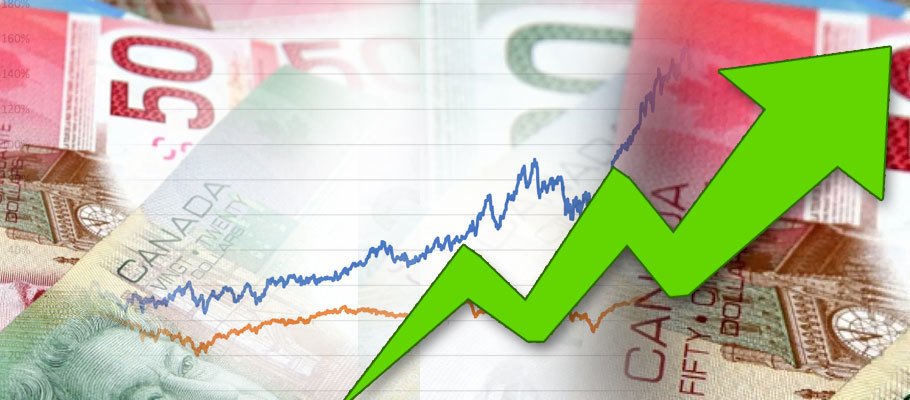
Published: October 16th, 2020
The Canuck dollar could strengthen by more than 0.6 per cent in the next three months, finishing the year at 1.31 per US dollar, according to a poll of more than 40 forex strategists. After that they say it could climb to 1.30 over the subsequent 12 month period.
One of the respondents, BMO Capital Markets in New York, told investors that the firm expects oil and other commodity prices to bounce back in the second half of 2021. That commodity price bump will push the loonie higher as well.
Oil is one of the country’s major exports, and crude prices have cratered by close to 40 per cent since the start of the year due to dramatically slowed global economic activity caused by the coronavirus pandemic and government lockdown measures.
While a separate Reuters poll last week predicted minimal upside for crude prices in the short term, next year could tell a different story.
Forecasts from the OECD earlier this month projected that the global economy would rebound by 5 per cent in 2021 after a contraction of 4.5% expected this year.
Economists look to what they see as Canada's effective response to the crisis and peg their hopes on the economy suffering less severely if there’s a second surge in infections in Autumn and Winter flu season.
While provincial governments are mainly working to avoid a new set of broad-based lockdowns, Prime Minister Justin Trudeau has said the government would continue assisting businesses and citizens to minimise the pandemic's influence on earnings and pocketbooks.
Ottawa projects a budget deficit of C$342 billion in the current fiscal year. Representing about 15 per cent of GDP, it would be the country’s most massive shortfall since the second world war.
Record low-interest rates set by the Bank of Canada and record government spending have helped keep the economy, and home prices, afloat.
Home prices have risen more sharply than expected this year, but look to increase by less than inflation next year as lower immigration and higher unemployment cool down buzzing markets in cities like Toronto and Vancouver.
The loonie could also see upside from wider weakness in the US economy if USD loses some of its fundamental support.
Currency strategists at Scotiabank in Toronto told reporters this week that the bank expects USD’s value to weaken somewhat over the next year, reflecting lower American economic growth and expected yield spreads. If those trends hold, it could push investors to diversify away from the dollar.
The Canadian dollar has been on an unprecedented journey this year, holding strangely firm amid the historic crude oil plunge.
While other oil-dependent economies like Mexico and Norway saw their currencies nosedive, the loonie typically defied the trend and held onto its value.
Crude oil and the Canadian dollar had been aligned for most of 2019. But when the pandemic brought the world’s economy to a screeching halt, it hammered demand for crude even as an oil-price battle was heating-up between Russia and OPEC over market share.
Since then, the oil-dollar connection has been less predictable. It de-coupled further in May when commodity investors offloaded oil futures contracts on expectations of a storage capacity crunch.
Market watchers had numerous perspectives on why the oil-loonie link might have broken down. Some said investors had already priced-in the impact of oversupply and weak demand.
Others pointed to the threat of a crash in bubbling urban property markets, and Canada’s high consumer debt levels, both of which could hurt the economy and break the relationship between currency and oil prices.
The Canadian dollars relative stability compared to other oil-economy currencies and the slumping crude market supports the notion that neither short-term moves in crude nor extreme price dips won’t have a lasting impact on Canada’s economy.
While cratering prices for Western Canada crude means the country’s oil producers will be in the red for the foreseeable future, perceptions of sector disarray could also mean the loonie is protected from sudden jumps and drops in the oil market.
Over the longer-term, however, low crude prices could herald difficulties ahead for Canada’s economy. The commodity reliant country could see its trade and current account deficits rise. Canadian households have been accumulating credit card debt, while housing markets could burst if unemployment and the overall economic outlook worsens.
Despite the rosy picture for the loonie in Q4, the US Federal Reserve is driving the global monetary policy response to the pandemic. US central bankers have been buying bonds aggressively and extending corporate credit, all while slashing interest rates to zero.
The ongoing American stimulus program was extended earlier this year to purchases of City-level debt from smaller American municipalities where businesses are feeling lockdown’s bite is being felt most painfully.
Given how dramatic its actions to counter economic damage have been, analysts say further big policy moves from the Fed are unlikely. That will impact how Canada’s central bank manages currency policy.
In a recent market commentary, TD Bank’s currency unit pointed out that central banks around the world have been making big asset purchases on a scale and frequency not previously seen outside of wartime. Most have reached their lower interest rate minimum bound and have had to stay there for months.
That’s helped stabilise exchange rates, but also left the globe's central bankers with less wiggle room than they had at the start of the year. They won’t be able to act with the same force should COVID-19’s expected Winter surge tank their economies even further.
The European Central Bank (ECB) is still pursuing a programme of bond purchases to fund further stimulus, but inter-region disagreements over rescue package may hamper more decisive action.